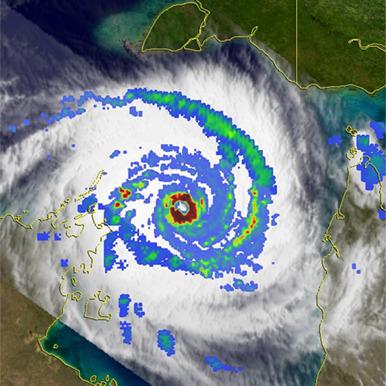当前位置:
X-MOL 学术
›
Int. J. Climatol.
›
论文详情
Our official English website, www.x-mol.net, welcomes your
feedback! (Note: you will need to create a separate account there.)
Global climatology of rainfall rates and lifetime accumulated rainfall in tropical cyclones: Influence of cyclone basin, cyclone intensity and cyclone size.
International Journal of Climatology ( IF 3.5 ) Pub Date : 2020-08-18 , DOI: 10.1002/joc.6763 Sally L. Lavender 1 , John L. McBride 2, 3
International Journal of Climatology ( IF 3.5 ) Pub Date : 2020-08-18 , DOI: 10.1002/joc.6763 Sally L. Lavender 1 , John L. McBride 2, 3
Affiliation

|
Seventeen years of 3-hr, 0.25° resolution, precipitation data from the Tropical Rainfall Measurement Mission (TRMM) multi-satellite precipitation analysis (TMPA) product are used to develop a global climatology of precipitation in tropical cyclones (TCs). Due to very large SDs for rainfall in each stratification by intensity class or cyclone basin, our methodology concentrates on frequency distributions and percentage representation in different rainfall rate categories. The stratifications reveal that the TC rainfall climatologies are dependent on three inter-related factors: TC intensity, TC size and TC basin. The interdependence of the three is examined. The distributions of TC intensity classes in the different basins are not a significant contributor to the fact that certain basins (Northwest Pacific, North Atlantic) have higher TC rainfall rates than other basins (Northeast Pacific, South Indian). In contrast to this, the distributions of TC size classes between basins are a significant contributor to why some basins are wetter than others. A climatology is also presented of lifetime accumulated rainfall (LAR) in TCs. The record LAR belongs to hurricane Ivan in 2004, with 300 km3 of rain over the 0–350 km radius, and 432 km3 over 0–500 km. The largest LAR values occur almost exclusively in two cyclone basins: The Northwest Pacific and the North Atlantic. Not unexpectedly, LAR is determined primarily by TC duration, which accounts for around 70% of the variance. Examination of the full 17-year dataset reveals a decreasing trend in both median and extreme TC rainfall rates in all basins except the Northeast Pacific. However, mechanisms responsible for this decrease are yet to be identified and may be primarily due to the sample size or data inhomogeneities. The difference between the trends and those expected from physical principles is a concern which we hope will be taken up by other investigators.
中文翻译:

热带气旋降雨率和终生累积降雨量的全球气候学:气旋盆地、气旋强度和气旋大小的影响。
来自热带降雨测量任务 (TRMM) 多卫星降水分析 (TMPA) 产品的 17 年 3 小时、0.25° 分辨率降水数据用于开发热带气旋 (TC) 降水的全球气候学。由于按强度等级或气旋流域划分的每个分层中降雨量的 SD 非常大,我们的方法集中于不同降雨率类别的频率分布和百分比表示。分层显示,台风降雨气候取决于三个相互关联的因素:台风强度、台风规模和台风盆地。三者的相互依存关系得到了检验。不同盆地 TC 强度等级的分布对于某些盆地(西北太平洋、北大西洋)的 TC 降雨率高于其他盆地(东北太平洋、南印度)。与此相反,盆地之间 TC 大小等级的分布是导致某些盆地比其他盆地更湿的重要原因。还介绍了 TC 中终生累积降雨量 (LAR) 的气候学。创纪录的 LAR 属于 2004 年的飓风伊万,在 0-350 公里半径范围内降雨量为 300 平方公里,在 0-500 公里范围内降雨量为 432 平方公里。最大的 LAR 值几乎只出现在两个气旋盆地:西北太平洋和北大西洋。不出所料,LAR 主要由 TC 持续时间决定,约占方差的 70%。对完整的 17 年数据集的检查显示,除东北太平洋以外的所有盆地的中值和极端 TC 降雨率均呈下降趋势。然而,造成这种减少的机制尚待确定,可能主要是由于样本量或数据不均匀所致。趋势与物理原理所预期的趋势之间的差异是我们希望其他研究人员能够解决的一个问题。
更新日期:2020-08-18
中文翻译:

热带气旋降雨率和终生累积降雨量的全球气候学:气旋盆地、气旋强度和气旋大小的影响。
来自热带降雨测量任务 (TRMM) 多卫星降水分析 (TMPA) 产品的 17 年 3 小时、0.25° 分辨率降水数据用于开发热带气旋 (TC) 降水的全球气候学。由于按强度等级或气旋流域划分的每个分层中降雨量的 SD 非常大,我们的方法集中于不同降雨率类别的频率分布和百分比表示。分层显示,台风降雨气候取决于三个相互关联的因素:台风强度、台风规模和台风盆地。三者的相互依存关系得到了检验。不同盆地 TC 强度等级的分布对于某些盆地(西北太平洋、北大西洋)的 TC 降雨率高于其他盆地(东北太平洋、南印度)。与此相反,盆地之间 TC 大小等级的分布是导致某些盆地比其他盆地更湿的重要原因。还介绍了 TC 中终生累积降雨量 (LAR) 的气候学。创纪录的 LAR 属于 2004 年的飓风伊万,在 0-350 公里半径范围内降雨量为 300 平方公里,在 0-500 公里范围内降雨量为 432 平方公里。最大的 LAR 值几乎只出现在两个气旋盆地:西北太平洋和北大西洋。不出所料,LAR 主要由 TC 持续时间决定,约占方差的 70%。对完整的 17 年数据集的检查显示,除东北太平洋以外的所有盆地的中值和极端 TC 降雨率均呈下降趋势。然而,造成这种减少的机制尚待确定,可能主要是由于样本量或数据不均匀所致。趋势与物理原理所预期的趋势之间的差异是我们希望其他研究人员能够解决的一个问题。











































 京公网安备 11010802027423号
京公网安备 11010802027423号